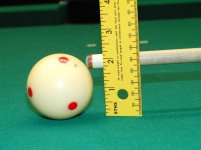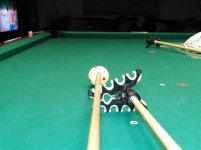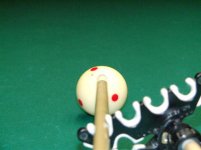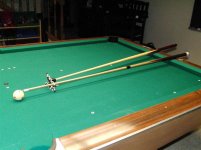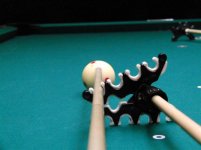As to the followthrough- As to the actual shot, that means the action on the cb, no more than at most 1/4" follow through is required. By that distance, the cb is gone from the tip, so no amount of follow through can possibly influence the action on the cb. That is just plain science.
Now, as far as the human condition, in most cases, follow through is a requirement. It is for the reasons you stated. That is, to ensure that we aren't slowing the cue down on the way to the cb. The follow through is not so much a requirement, as it is a result of a good stroke. There are ways to not impede the action of the stroke without hardly any followthrough. One such way is to ensure that your back hand hits the table to stop any follow through. Another way, is to choke up on the cue so that if you use a pendulum stroke, your chest will stop the cue with very little follow through.
Since, scientifically, it has been proven that follow through is a non-requirement, it behooves the shooter to find ways that help eliminate that unwanted body motion that does nothing for the shot while at the same time not inhibiting any of the stroke up until contact with the cb.
The most common way to achieve that would be by use of the pendulum stroke. Instead of dropping the elbow, and adding unwanted body motion to the equation, nothing moves except the forearm. The distance of the follow through of the cue after contact becomes inhibited by contact of the hand against the chest. Thereby, not affecting the speed of the stroke before contact.
Another way to look at it is by looking at a masse shot. No shot gives more spin than a full masse. Yet, how long is the follow through? No more than the height of the cb. In the case of a masse, the follow through is inhibited by the bed of the table. Yet, no followthrough does not affect the outcome of the shot at all.
The more body motion you put into the shot to achieve some desired result, the more things that can go wrong with the shot. And, the more likely you are to NOT hit the exact spot on the cb that you are aiming for. For instance- trying to draw the cb- if you hit even just 1/2 tip higher than you were aiming because you are trying to put your arm and shoulder, or worse yet, your body, into the shot to get more cue speed, you will actually get less draw than if you hit the cb at the correct spot.
In essence, follow through is not the CAUSE of a good stroke, however, it can be the RESULT of a good stroke.
